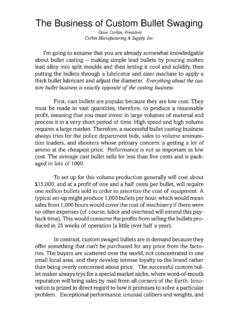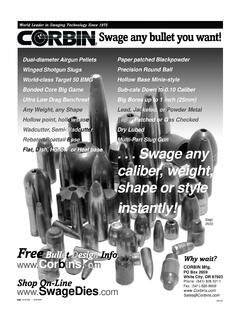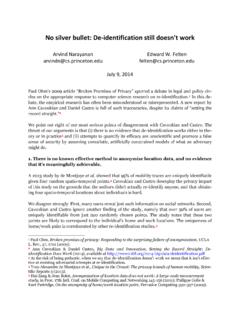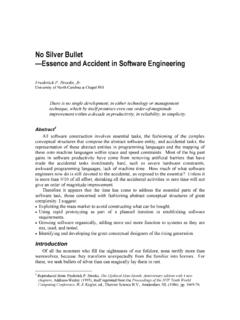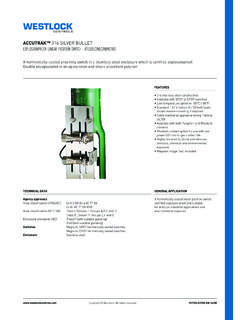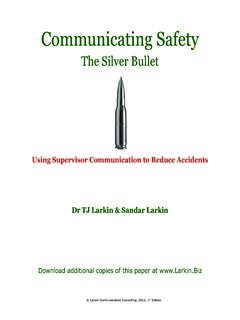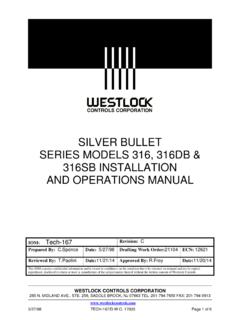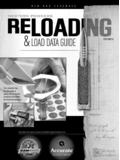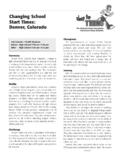Transcription of Operation of the Point Forming Die - Corbin Bullet Swaging ...
1 1 External punchPF-1 diePress RamEjection pin(Internal punch)Stop PinPunch HeadOperation of the Point Forming DieLEFT: Swagingthe Bullet to finalshape in the pointforming die. Theejection pin ispulled downbecause the StopPin engages aslot in the : Ejectingthe finished bullettakes place whenthe ram internal punch has ahead which stops thepunch at a given depth inthe die. Shorter headsmake longer bullets andlonger heads makeshorter bulletHeavy bulletTOP: Swaging stroke head of punch contacts shoulder in : ejection stroke stop pin pushes punch forward to Head RingHex BushingPunch TipExternal Punchand Floating PunchHolder retainers fortype -M or -S dies(Type -H externalpunches areretained by a hexbushing withoutthe ring)Floating Punch HolderThe FPH-1-M punch holder fits boththe Series II and Silver Press, andholds the external type -M or -Spunch (which is the same punch,used with both -M and -S dies), withthe ring and retainer bushing FPH-1-H punch holder fits theCSP-2 Mega-Mite, CSP-2H HydraulicMega-Mite, and CHP-1 ring is Guard BulletsThe BG design uses copperdisk to scrape foulingfrom the punch for BG has a small depressionin the exact center, which forms anextruded lead rivet to hold the disksecurely on the base.
2 The conical-shapeddisk flattens and expands in the die toprecise Bullet Base, Lead Tip Bullet being finishedin the LT-1 LT-1 lead tip Forming die must be usedwith an internal punch matching the bulletogive, and anexternal punchmatching the bulletbase. The LT-1 canbe used withjacketed or leadbullets to form afactory-finishedappearing the Mega-Mitehand press, thereare three ejectionbars to matchthree standardlengths of internalpunches. Thecombination of ejection bar and punch resultsin a constant length when properly punches use the taller bar, and viceversa. In the Hydro-Press and HydraulicMega-Mite, one ejection bar can be used withall punches because the ejection Point is setby a position sensor, rather than being fixedby the press pin (1/4 inch diam.) fitsunder the retraction bar (fits through the ram,under the internal punch head)Hydro-Press and Mega-MiteEjection bar and Retraction pinassembly1. DIE2. INTERNAL PUNCH3. RETRACTION SPRING4.
3 RETRACTION PIN5. EJECTION BAR6. MOUNTING PLATE7. RAM123456712 3 4567 Ejection Swaging5 Flat Base Internal Punch (usedin CS-1, LSWC-1, CSW-1 dies)Dish Base Internal Punch (usedin CS-1, LSWC-1 for shallowconcave base shape)Cup Base Internal Punch (usedin CS-1, LSWC-1 for paper-patched bullets, some handgunbullets)Hollow Base Internal Punch(used in CS-1, LSWC-1 for leadblack powder and somehandgun bullets)TWCBWC Keith Conic 1-ESWCAL3/4-ESWCB ullets that can be made in a single die using the punch cavity toform the nose (no Point Forming die required)From Left: Target Wadcutter, Button Nose Wadcutter, Keith SWC,Conical SWC, 1-E round nose SWC, 3/4-E round noseSWC, and Auto Loader and core length determine Bullet styleThe same length jacket (first two on left) can make open tip or leadtip bullets depending on core length. From left: open tip, lead same core length (last three on right) can make various pistolbullets with different jackets.
4 From third left: full jacket soft Point , 3/4-jacket, and half-jacket (about twice as long as a gas check).Ring DieRimfire jacketJacketDrawn casePunch (fits press ram)Drawing a rimfire case is like reducing abullet jacket. Fired .22 case is placedover the tip of a punch, and pushed intothe draw die (RFJM-22) to unfold thehead and decrease the set for rifle or handgunbulllets consists of (1) CS-1-RCore Seater, and (2) PF-1-R PointFormer. The Knock Out Rod isshown at right (one KO Rod fitsboth dies).CS External Punchesshowing jacket ExternalPunchEC-1-R Econo Swage DieRetainer BushingKnock Out RodInternal PunchDie BodyCorbin Screwless Lock NutExternal PunchEjection8 RFJM-6 MMThe 6mmand 224jacketmakers usethe samedie, butdifferentpunchesand ejectorring rodRing die insertType -R punch(224 calibershown)Make a short core to fit main jacketcaliber (may require long punch head)Seat the core in the inner jacket usingproper caliber CS-1 die. Insert into theouter jacket.
5 Note lead a smaller diameter core to fit intothe inner jacket (use CSW-1 die for thesmaller caliber. Core must extend beyondjacket the assembly in the outer jacketin the normal size CS-1 die. Finishin PF-1 die as with any (Tangential Ogive) Bullets are measured incalibers of radius. Illustrated is a 3-1/4 S ogive. Thenose is part of a circle with a caliber LTCB Int. punchSwaging a paper patched rifle Bullet (1-E nose, Cup Base)The LSWC-1 die forms the nose in a punchcavity. The edge of the punch leaves ashoulder on the Bullet . The paper patch canbe wrapped slightly over this shoulder tohelp prevent tearing when HP bulles can be swaged in two ways. First, youcan use a custom SWC punch to form the Bullet shown abovein a single stroke. Second, you can use a separate post- Forming HP punch to seat the core, then form the ogive in apoint Forming die. This eliminates the SWC shoulder. 1 2 31. Core toolight orjacket toolong punch hitsjacket Perfect fit11 Lead tip bullets can be made more precisely by using the LT-1 Lead Tip Forming Die (do not confuse the TIP Forming die withthe Point Forming die the Point former refers to the entireogive or nose curve, and the tip ONLY refersto the very end of the Point or ogive).)
6 The LT-1 die has an internal punch (shown)which shapes the lead extruded from thejacket end when you form the ogive. Very lightpressure is used to avoid putting a shoulder inthe jacket from the punch Point is a termused to describeconical or angled riflebullet noses. It isessentially a jacketedconical style with along conical nose bulletgenerally is of theSemi-Wadcutterstyle, having ashoulder and a lead TRUNCATEDCONICAL or TCstyle is a cut-off(truncated) coneshape. It can bemade without ashoulder, in theTC Point form KEITH nose isa TC SWC Bullet ,with a lead noseformed in Core Curve Open Base Roll Base Flatten BaseMaking a FMJ Bullet in PF-1 DieCSPFBaseRollCore Swage Die (CSW-1) also similar to LSWC-1 Lead Semi-Wadcutter die in Seating Die (CS-1) also similar to LT-1 Lead Tip Former Forming Die (PF-1) also similar to RB-1 and BT-2 dies (partof RBT-2 set) in Boattail BulletStreamlined base directs muzzle blast gasin a laminar flow pattern, breaking up in front of thebullet, contributing to larger Boattail BulletShoulder acts as a spoiler todeflect muzzle blast gas in a ring,leaving a clear path in front of thebullet , aiding smaller 2 3 TOP: FormingHollow Point inthe core seatingoperation, usingexternal HP : Forming theogive in thePoint Formingdie changes theshape of the Point Bullet Making1.
7 Core Seating punch is too small for the jacket wall thickness orlength of core. 2. Perfect fit. 3. Core Seating punch is too large forthe wall thickness (may fit with a heavier core or thinner jacket).15 Bullet Reducting Die (BRD-1)Guide bushingRing Die (constriction)Ring Die (mouth)BRD Punch (fits pressram; die fits press head)Maximum practical reduction of a Bullet isnormally about .005 Patched BulletsABOVE: 1-E CB LSWC style, can bemade in a single stroke in theLSWC-1 : Smooth ogive 1-E CB bulletmade in two dies (CSW-1 and PF-1)to eliminate the Ogive Bullet - used in (Ultra-Low Drag) designTangentpointSame curveattachedtangent toshank makesbullet too longSecant isoffset andmoved backfrom tangentShankOpen TipMultiple Jacket BulletThe Multi-jacket design provideseven more protection than thepartition style, launching a wadcut-ter within a streamlined SPIRE Point Bullet would be called a conical in shorter,pistol styles. It uses a straight, angled nose rather than a curvedogive nose, joining the shank at an Core Seating PunchThis punch is alwaysused with hollow pointlead tips to avoiddamaging the sharpedges of the punch.
8 Theedges of the jacket arejust barely cut, so thejacket opens quickly onimpact along each Bullet Polisher KitThe mounting bracket isused to fasten the vibratormotor to the bottom of abucket, coffee can, or pan,which in turn is suspendedby a bail or, better still, adoor spring. Proper locationof the motor will result inpowerful churning action inthe walnut shell Dual Diameter BulletDual Diameter bullets solve several problems for shooters,including feeding of long or heavy bullets into short-throatedbarrels, better alignment than a tapered Bullet with excellentreduction of bore friction. The rear portion of the Bullet is madegroove to groove diameter; the front portion is bore BallsPlastic spherescan be used ei-ther in the tip ofa hollow pointbullet, as a kindof pneumaticexpander, or toshift the balanceand lighten thebullet, for highspeed yet lengthShank area of bulletElliptical ogiveThe elliptical ogive ismeasured not by theradius of the curve,but by the axiallength of the nosesection.
9 Unlike aspizter (tangent)ogive, the ellipticalogive has a constantlychanging radius, and crosses thecenterline of the Bullet (at the tip) atexactly 90 degrees to the centerline. It begins tangent with the shank, likea spitzer ogive. The two most practical lengths are the 3/4-E and the 1-Eogive, for pistol and rifle Expand/Trim SetKnock-out rodDraw/Trim DieTrim Length AdjustmentPinch Trim Punch(One requiredfor each length)Internal punchExpander dieExpanderPunchH S M RRelative Sizes of Corbin Dies Thread Diameter H 1X12 1-1/2 inch S 5/8 X 24 1 inch M 5/8 X 24 3/4 inch R 7/8 X 14 adapter 5/8 inch21 Ejection Pins (Internal PFpunches)-R-M-S-HBT-1BT-2 RBT-2 Rebated Boattail 2-Die SetThe core is seated in BT-1 die with drawn jackets, or a special BTforming punch is used with tubing jackets. Then the core is seated(again) in the BT-2 die, in order to form the rebate edge.
